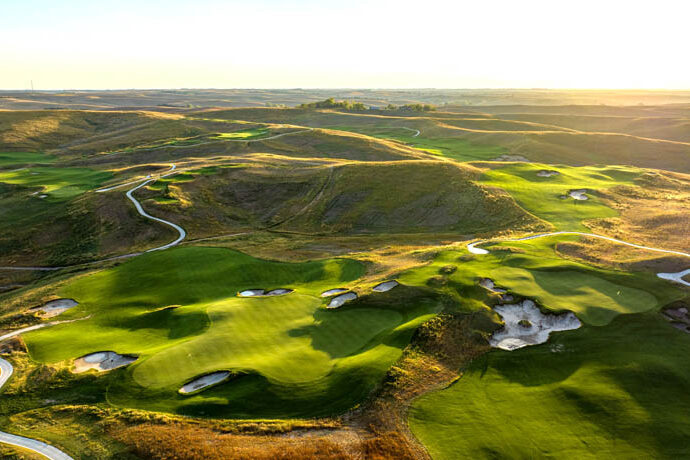Great golf, but be prepared to drive
I got a lot of puzzled looks this past spring when friends broached the topic of the destination for this summer’s annual golf trip.
Past trips have included Branson, Pinehurst, Myrtle Beach and Bandon Dunes. And there’s not a one in the bunch that could be considered an odd choice. This time, though, was different.
“We’re going to Nebraska,” I’d say.
“Nebraska? “Really?” folks quizzed, seemingly puzzled by the choice of a state that is not known for its golf.
My answer was always the same – “I’m going to find out if it is as good as what I have heard and read.”
The way things turned out – my sampling of golf in Nebraska turned out to be better than what had been rumored. If you hit the right spots, golf in Nebraska is better than good. It’s outstanding, and it’s totally different from what we have here in Alabama.
Part of the rationale for the trip is due in part to having played Sweetens Cove in South Pittsburg, Tennessee, numerous times. That quaint nine-holer in the Sequatchie Valley that has reached mythical proportions in the golf kingdom features outlandish greens complexes and a vibe that emphasizes having a good time over what you shoot.
It’s the product of Rob Collins and Tad King, who currently are one of the hottest design teams in the business. I fell in love with Sweetens the moment I walked up to the shed/clubhouse to check in and moments later had my first chip shot roll back down to my feet when I couldn’t cover the false front green on the second hole.
So, when I heard the King/Collins team was creating something special in some out-of-the-way outpost in Homer, Nebraska, it was a no-brainer to make the trek north from Florence, Alabama.
Landmand, the name of their Nebraska course, opened in late 2022 to rave reviews. Golf Digest rated it the No. 1 new public course that year. Golfweek proclaimed it No. 26 on its list of best modern courses.
There was only one problem – Homer is about a 14-hour drive from Florence. And who is going to drive that far to play 18 holes and turn around and come home?
And that’s when the idea hit. Back in the 1920s and 30s, major-league teams would barnstorm their way north from Florida at the end of spring training and play exhibition games in small towns and big cities. Why couldn’t we do the same thing in Nebraska? In fact, you almost have to barnstorm in order to hit the state’s great courses because they aren’t really clustered close together, and Nebraska is a big, long state.
The more I researched the trip, the more I realized logistics were going to be the biggest issue in addition to securing tee times and lodging. In case you hadn’t noticed, golf destinations are filling up quickly and in some instances you have to book more than a year out. That wasn’t completely true with this trip, but we did have to change our plans in order to hit Dismal River and the Prairie Club, two outstanding 36-hole golf-centric destinations in Nebraska’s Sand Hills.
In the end, four other golf writers and three friends met up for what turned out to be a really cool golf adventure.
The Trip
With tee times secured, Cullman Times sports editor Jake Winfrey and I loaded up our SUV rental on a hot, humid July Friday morning for the first leg of the trip – Kansas City. Note to those who might want to head out on a similar trip – if you don’t know somebody very well, you will by the time you’re more than 2,400-mile round trip adventure is over. Or, you will leave them deep in a Nebraska cornfield to find their own way home. Fortunately, Jake and I are frequent playing partners and we have sports journalism in common, so we get along.
Because we didn’t have anywhere to be until Sunday when we had to pick up alabamagolfnews.com co-owner and web editor Dan Vukelich at the airport in Omaha on Sunday, we opted for a warmup round in Kansas City at Swope Memorial Golf Course, a quaint little muni designed by A.W. Tillinghast that dates to 1934. It’s about to shut down for renovations, but at $50 on a Saturday afternoon it was well worth the stop.\
Swope Memorial is a short course that plays only 6,274 yards from the tips, but features small greens and there’s plenty of elevation changes that make it play longer than its listed yardage. Perhaps the biggest difference playing at Swope Park than somewhere in Alabama is that it has bentgrass fairways and rough. It was a pleasant change from the Bermuda grass we mostly play on in Alabama.
Nebraska’s motto: ‘Where the West Begins’
Landmand
First up in the Cornhusker State was Landmand. To get to the course from Sioux City, Iowa, you take a left off the paved highway and drive about three miles down a gravel road with nothing but cornfields on each side. The parking lot is nothing fancy, adjacent to the cart barn. Trust me, though, that when you top the hill headed to the modern, yet modest golf shop, you won’t be ready for the reveal of a massive, sprawling golf course set over 500 acres.
Even better, when you check in at the golf shop, they ask you to designate your ‘walk-up song.” For our foursome, I chose U2’s “It’s a Beautiful Day” to set the tone. We drove down to the starter’s booth where he sent us to the first tee with a simple “Have a day.”

Throughout the trip, we played the courses from yardages in the 6,000-yard range, although the par-73 Landmand tops out at 7,200 yards. Among the highlights are four drivable par 4s and a 100-yard par 3 that is among the hardest anywhere. Fairways are generous but what sets it apart is the massive, contoured greens and surrounds. They are wildly entertaining, and it would easily be possible to hit every green in regulation and not break 90.
How big are the greens? No. 10, Landmand’s punchbowl green, checks in at 20,000-square feet. (The average green is 3,000 to 5,000 square feet.). The first green at Landmand measures 13,725 square feet. The fifth hole’s green is 25,000 square feet. Get the picture – Collins and King are all-in on big, interesting greens.
Another benefit to playing Landmand – they only put out 28 groups a day, so pace of play is never an issue.
Tatanka Golf Club
It’s rare these days to find hidden gems, but that’s exactly what one encounters when pulling up to the Tatanka Golf Club. Owned and operated by the Santee Sioux Nation, Tatanka is adjacent to the Ohiya Casino Resort. Located northwest of Landmand, in Nebraska’s northeast corner, Tatanka sits almost on the Nebraska-South Dakota border in Niobrara.

Designed by Paul Albanese and opened in 2015, Tatanka’s landscape differs from Landmand in that it is more of a parkland course dotted with hardwoods among the prairie. Natural elevation changes make the course play seemingly longer than its scorecard yardage – we played from 6,223 yards but it tips out at 7,450.
Director of Golf Troy Harder has worked hard at changing the image of “hidden gem” to a must-play destination for visitors and locals alike. He’s already seeing results from a marketing campaign and rounds are up over 2023.
“I would say this course is very unique, very playable, other than our bunkers are a little tough right now with all the grass, but the average player – higher than bogey golf – can come and play here,” Harder said. “When I first started, I didn’t think that we would have that type of player. I thought it would be 20 and lower handicap because of the golf course and the difficulty.”
Seemingly one trend in Nebraska is allowing the thick native grasses to grow in abundance around the bunkers. Most of the time it’s better to land in the bunker than to be barely outside it due to the thickness of the surrounding grass. An added touch is that Albanese designed many of the bunkers to resemble animals or footprints.
Like Landmand, Tatanka is spread out over nearly 500 acres, giving players a sense of solitude while on the course. That was another trend of the courses we played in Nebraska – their expanse rarely makes a player feel crowded.
“You really feel like you are out here by yourself,” Harder said.
Tatanka’s rolling fairways rarely offer a level lie and each tee sign gives the hole’s name and a short story. The price is right, too. Tatanka, which surely should be listed among the top public courses in Nebraska, can be played for $80.
Dismal River Club
A three-hour drive from Tatanka brought us to the Dismal River Club in Mullen, a spectacular 36-hole complex featuring the Jack Nicklaus-designed White Course and the Tom Doak-designed Red Course. There’s a lodge, cabins and a clubhouse offering superb views of the surrounding countryside.

Set in the true Sand Hills portion of Nebraska, the terrain was formed by sediment that eroded from the Rocky Mountains and washed into the plains by wind and rivers that are now covered in grass. Quotes from Nicklaus and Doak capture the flavor of the site:
“The experience of arriving at the Dismal River site was like stepping back in time and seeing what the dunes of Northeast Scotland must have looked like a hundred years ago,” Nicklaus wrote on the White Course.
“The best designs of all are organic evolving from the subtleties of the ground they inhabit,” Doak wrote on the Red Course scorecard.
To get an idea of the enormity of the property, the drive from the clubhouse to the first tee on either course checks in at more than a mile along a dirt path.
Although the terrain seemingly appears to be suited to a links-style course, Nicklaus’s White Course is more target golf. That’s not to say it’s bad, just not what I was expecting. The most memorable hole on the White course is No. 10, a 167-yard par 3 (middle tees) with a pot bunker located in the middle of a long, skinny green.
While the fairways are wide, shots that stray from the short grass or don’t find the deep, gaping bunkers often come up missing.
Doak’s Red Course is more straight forward and offers plenty of options for approach shots. I loved the short par 4 No. 15 that plays a downhill 271 yards. While the tee shot looks inviting, a series of fairway bunkers can turn a birdie opportunity into a quick double bogey. And that’s exactly what a short par 4 should be.
The first eight holes play through the dunes, but the final holes are set among the lower part of the property and are stunning and dramatic.
Caprock Ranch

For me, if Landmand was 1A on the trip, Caprock Ranch, an exclusive Gil Hanse design, checked in at 1B. The course traverses through the sand hills and many of the holes are set along plateaus overlooking the Snake River Canyon. Golf Digest proclaimed Caprock Ranch its No. 1 new course in 2021 and it’s easy to see why. There are five par 3s and a bevy of short par 4s. Each nine closes with a par 3, and the finishing hole plays 196 yards over the canyon to a shallow green. Close with a par and retire to your cottage for a post-round celebratory beverage.
The downside of CapRock is that it is private. We played it on a Thursday and there was only one other group on the course. Find a member and hit them up for an invite. Thank me later.
The Prairie Club
Just down the road from CapRock Ranch is the Prairie Club that features the Dunes Course, designed by Tom Lehman and Chris Brands, the Pines Course, designed by Graham Marsh, and a short course designed by Hanse and Geoff Shackleford.

Part of the beauty of The Prairie Club and CapRock Ranch is that neither site is high on amenities. You come to the Prairie Club to play golf and it offers two incredible courses. The Dunes Course is ranked No. 41 on Golf Digest’s list of top 100 public courses, while the Pines Cours checks in at No. 88.
The Dunes Course offers wide fairways, penal bunkers and enormous greens complexes. And while it’s not hard to hit the fairways, finding the correct side from which to take on the pins can be challenging.
There are parts of the Pines Course that can fool a person into thinking they are playing in the Carolinas, Georgia or even Alabama. The Snake River Canyon plays a prominent role on the Pines Course, but also has many of the same features as its counterpart away from the holes that are played among the Pines.
Awarii Dunes
The final stop on what turned out to be a nearly 2,500-mile venture was Awarii Dunes, located on the outskirts of Kearney. We were hoping to play Wild Horse, another top-100 public facility but a tournament prevented that, so we opted for Awarii Dunes. We caught Awarii in between superintendents, so there were some turf issues that the staff was trying to overcome.
However, the bones of Awarri Dunes are solid. The greens were challenging and it’s easy to see why the course slogan is “Where Ireland meets the Heartland”. Jim Engh designed Awarii Dunes as a tribute to the links courses of Ireland. In prime condition, Awarii Dunes is a good value course with an interesting mix of holes.
Final takeaway
Golf in Nebraska fulfilled all of our expectations. But more than the great golf we encountered, it was the lay of the land that caught my attention. We started off in a part of the state in which corn, sorghum and soybean fields dotted the landscape before immersing ourselves in the sandhills, where prairies and cows were the norm.
Driving through the Nebraska countryside in the late afternoons and evenings while rarely encountering another vehicle provided a sense of freedom. Watching a distant thunderstorm with lightning lighting up the sky was akin to watching a July 4th fireworks display.
The trip was so good, I think I’ll go back.
Gregg Dewalt is the editor of Alabama Golf News
Have a story idea or a news item to report to Alabama Golf News? Email gregg@alabamagolfnews.com
Featured image No. 1 green at Landmand courtesy of Landmand Golf Club







